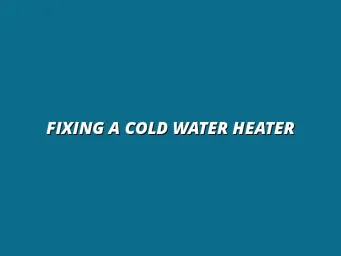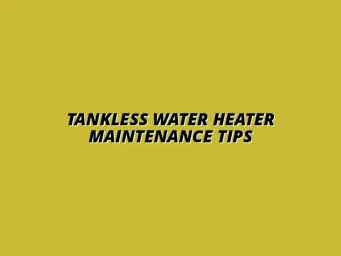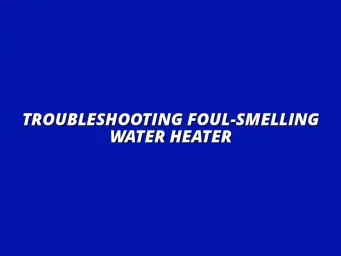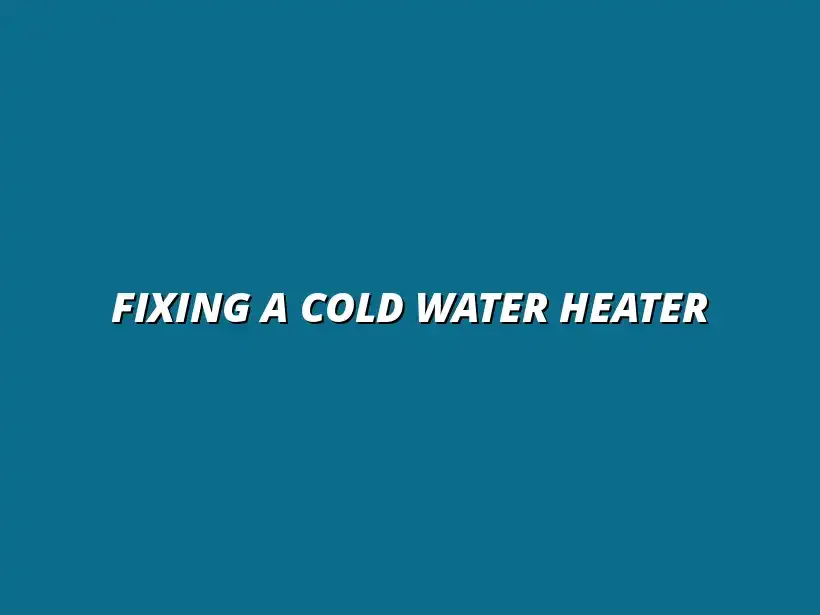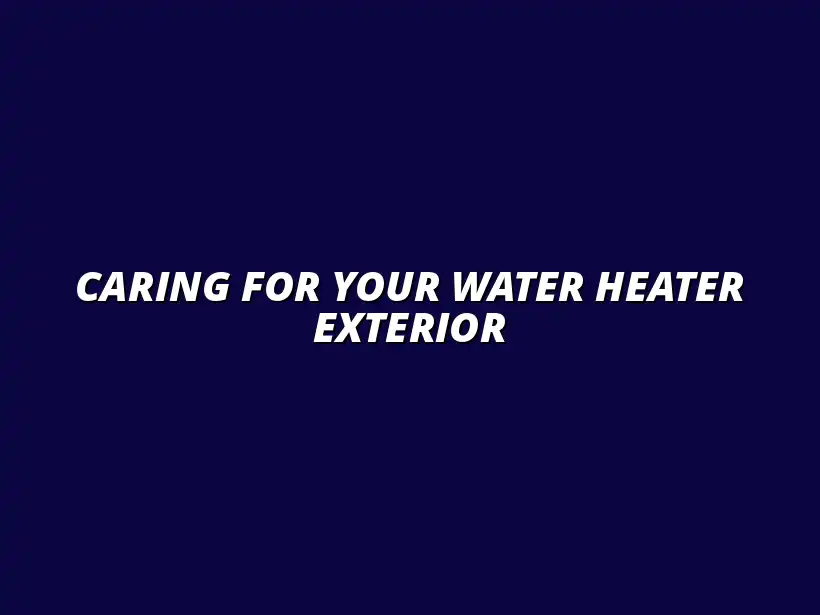
Caring for Your Water Heater Exterior
Understanding the Importance of Water Heater Exterior Maintenance
Maintaining the exterior of your water heater is often overlooked, but it plays a crucial role in its overall performance. Regular maintenance not only safeguards your investment but also ensures the safety and efficiency of your home’s hot water system. Taking the time to care for your water heater can lead to a longer lifespan and fewer headaches in the long run! For more tips on maintaining your water heater efficiently, check out this helpful guide: maintain your water heater efficiently.
Why Regular Maintenance of Your Water Heater Matters
When you think about water heater maintenance, you may not realize just how vital it is. Regular upkeep can help you prevent costly repairs and enhance the efficiency of your unit. By neglecting this crucial aspect, you could be setting yourself up for major malfunctions or breakdowns that could have been easily avoided. Regular checks, including flushing your water heater, are key to preventing issues. Learn how to flush your water heater easily and keep it running smoothly.
Preventing Costly Repairs through Proactive Care
By keeping an eye on your water heater's exterior, you can spot issues before they turn into major problems. This proactive care can save you a substantial amount of money. Here are some ways regular maintenance helps to avoid costly repairs:
- Identifying leaks early can prevent water damage.
- Cleaning the exterior reduces wear and grime build-up.
- Monitoring the pressure relief valve avoids dangerous situations.
Enhancing Energy Efficiency with Proper Maintenance
Another important benefit of regular water heater maintenance is improved energy efficiency. When your water heater operates efficiently, it uses less energy, leading to lower utility bills. Simple tasks like cleaning and checking components can have a significant impact on how well your system works! Regular anode rod replacement is also crucial for efficiency and longevity. Discover the benefits of regular anode rod replacement here.
Recognizing the Components of Your Water Heater’s Exterior
Understanding the different parts of your water heater’s exterior can empower you to take better care of it. Each component has a specific function that contributes to its overall operation. By familiarizing yourself with these parts, you can identify potential issues more easily and keep your hot water running smoothly.
Identifying Key Parts of the Water Heater Exterior
There are several key components on the exterior of your water heater that need your attention. Knowing their functions can help you maintain your system effectively. Here’s a quick overview of these essential parts:
- **Insulation** – Helps to keep the energy inside the tank.
- **Pressure Relief Valve** – Ensures safety by releasing excess pressure.
- **Drain Valve** – Allows for draining sediment from the tank.
Understanding the Role of Insulation
Insulation is a critical part of your water heater’s design. It minimizes heat loss, keeping your water hot for longer periods. Without proper insulation, your water heater has to work harder, which can lead to increased energy costs and a shorter lifespan!
Recognizing the Importance of the Pressure Relief Valve
The pressure relief valve is a small but vital component of your water heater. It helps prevent excessive pressure build-up, which can lead to catastrophic failures. Regularly checking that this valve is functioning properly can keep you and your home safe from potential hazards. For regular bathroom water heater checks and maintenance advice, see this page.
Common Issues Affecting Water Heater Exteriors
Being aware of common issues that can affect your water heater’s exterior is important for effective maintenance. Problems like corrosion and dirt accumulation can significantly impact performance. Here are some common issues to watch for:
- **Corrosion and rust** – These can weaken the structure of your unit.
- **Dirt and dust accumulation** – These can block vents and reduce efficiency.
- **Leaks** – Small leaks can lead to larger issues if not addressed quickly.
Corrosion and Rust: Signs to Watch For
Corrosion and rust are serious concerns for any water heater. Look for discoloration or flaking paint, as these are signs that your unit may be at risk. If you notice any of these signs, it’s important to act quickly to prevent further damage!
Impact of Dirt and Dust Accumulation
Dirt and dust can accumulate on your water heater, leading to reduced efficiency. A buildup can insulate parts of the unit, causing it to work harder and use more energy. Regular cleaning and inspections are crucial to keep your water heater in top shape. Preventing scale buildup is also vital for maintaining efficiency. Learn how to prevent scale buildup in your water heater.
Effective Techniques for Maintaining Your Water Heater’s Exterior
Maintaining the exterior of your water heater is crucial for keeping it functioning properly and extending its lifespan. By following effective techniques, you can ensure that your water heater remains in optimal condition. Regular maintenance not only prevents problems but also enhances the overall efficiency of your system. Addressing issues promptly is key; consider contacting a local plumber if needed. Find a plumber in Billesley, Birmingham for assistance.
When it comes to maintenance, there are various approaches you can take. These include routine cleaning practices and thorough inspections of your water heater. By implementing these strategies, you can catch potential problems early and avoid costly repairs down the line!
Routine Cleaning Practices for Optimal Performance
Keeping your water heater clean is one of the simplest ways to maintain its performance. It’s important to regularly clean the exterior to prevent dirt and grime buildup that can hinder its efficiency. With just a few easy steps, you can keep your water heater looking and functioning like new. Effective drainage is also important for preventing water damage around your water heater. Find out more about effective drainage for rainy areas.
Here are some effective steps to safely clean the water heater exterior:
- Turn off the power supply or gas to the water heater.
- Use a damp cloth to wipe down the surface, removing any dust and dirt.
- For tougher stains, use a mild detergent mixed with water.
- Rinse the surface with clean water and dry it thoroughly.
Steps to Safely Clean the Water Heater Exterior
Before you start cleaning, make sure to prepare your workspace. Having the right tools and cleaning solutions can make a big difference in effectiveness. Always prioritize safety first to ensure a smooth cleaning process!
Here’s a list of recommended cleaning solutions and tools:
- Microfiber cloths for gentle cleaning.
- Mild detergents (avoid harsh chemicals).
- Soft-bristle brushes for scrubbing stubborn spots.
- Protective gloves to keep your hands safe.
Inspecting and Addressing Damage on the Water Heater
Regular inspections are key to spotting any wear and tear on your water heater. By checking for signs of damage, you can address issues before they escalate into bigger problems. It’s a good idea to incorporate inspections as part of your regular maintenance routine.
When conducting inspections, pay attention to certain areas that are prone to damage. Look for signs of rust, leaks, or loose fittings. It’s also important to listen for unusual noises that might indicate a problem. Catching these issues early can save you time and money!
Conducting Regular Inspections for Wear and Tear
To ensure a thorough inspection, follow these simple steps:
- Check the pressure relief valve for proper operation.
- Examine the insulation for any signs of wear.
- Look for rust or corrosion on the tank.
- Inspect connections and hoses for any leaks.
By following these steps, you can ensure your water heater remains in good condition for many years to come.
Repairing Minor Issues Before They Escalate
If you spot any minor issues during your inspections, it’s essential to address them immediately. Small repairs can prevent larger, more expensive problems later on. Sometimes, a simple fix is all that’s needed to maintain efficiency!
Here are a few examples of minor repairs you can do:
- Tighten loose fittings to stop leaks.
- Replace worn insulation to maintain energy efficiency.
- Clear debris from around the heater to ensure proper air circulation.
Taking these proactive steps will help you keep your water heater in top shape.
